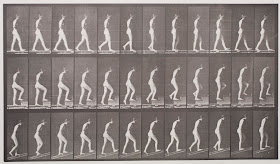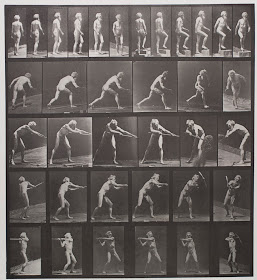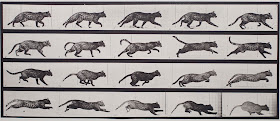 During the late nineteenth century, a hotly debated topic among horse racing aficionados was whether all four of a horse's feet left the ground during trotting and galloping. Leland Stanford - former governor of California and a proponent of the "unsupported transit" theory - hired Eadweard Muybridge to settle the issue. This was the start of Muybridge's fascination with and exhaustive study of animal and human locomotion which culminated in his famous 11 volume Animal Locomotion. An Electro-photographic Investigation of Consecutive Phases of Animal Movements (Philadelphia: University of Pennsylvania, 1887).
During the late nineteenth century, a hotly debated topic among horse racing aficionados was whether all four of a horse's feet left the ground during trotting and galloping. Leland Stanford - former governor of California and a proponent of the "unsupported transit" theory - hired Eadweard Muybridge to settle the issue. This was the start of Muybridge's fascination with and exhaustive study of animal and human locomotion which culminated in his famous 11 volume Animal Locomotion. An Electro-photographic Investigation of Consecutive Phases of Animal Movements (Philadelphia: University of Pennsylvania, 1887).Muybridge's photographs documented specific sequences of motion - typically performed in front of a gridded background to provide for quantitative comparison. The human actions captured in these images were wide ranging: walking up and down stairs, hammering on an anvil, playing cricket, and many everyday activities. Most of these actions were performed by nude or very lightly clothed models - presumably to allow for the study of individual muscle movement. However, the often bizarre and contrived actions in some sequences (most often those depicting women) do lead to speculation that some of these images may have also been used as light erotica. Muybridge used many different models and included himself in at least one sequence swinging a pick. His assistant Thomas Eakins was also posed for several studies.
Animals were also photographed in the same deliberate fashion: typical motions of a wide range of domestic and wild fauna including horses, goats, cats, dogs, various birds, monkeys, bison, and many other species were documented. Horse studies occupy an entire volume while the rest are split into one volume of domestic animals and one of wild.
Ask for Rare Book QP 301 .M8 to see the entire set.




No comments:
Post a Comment